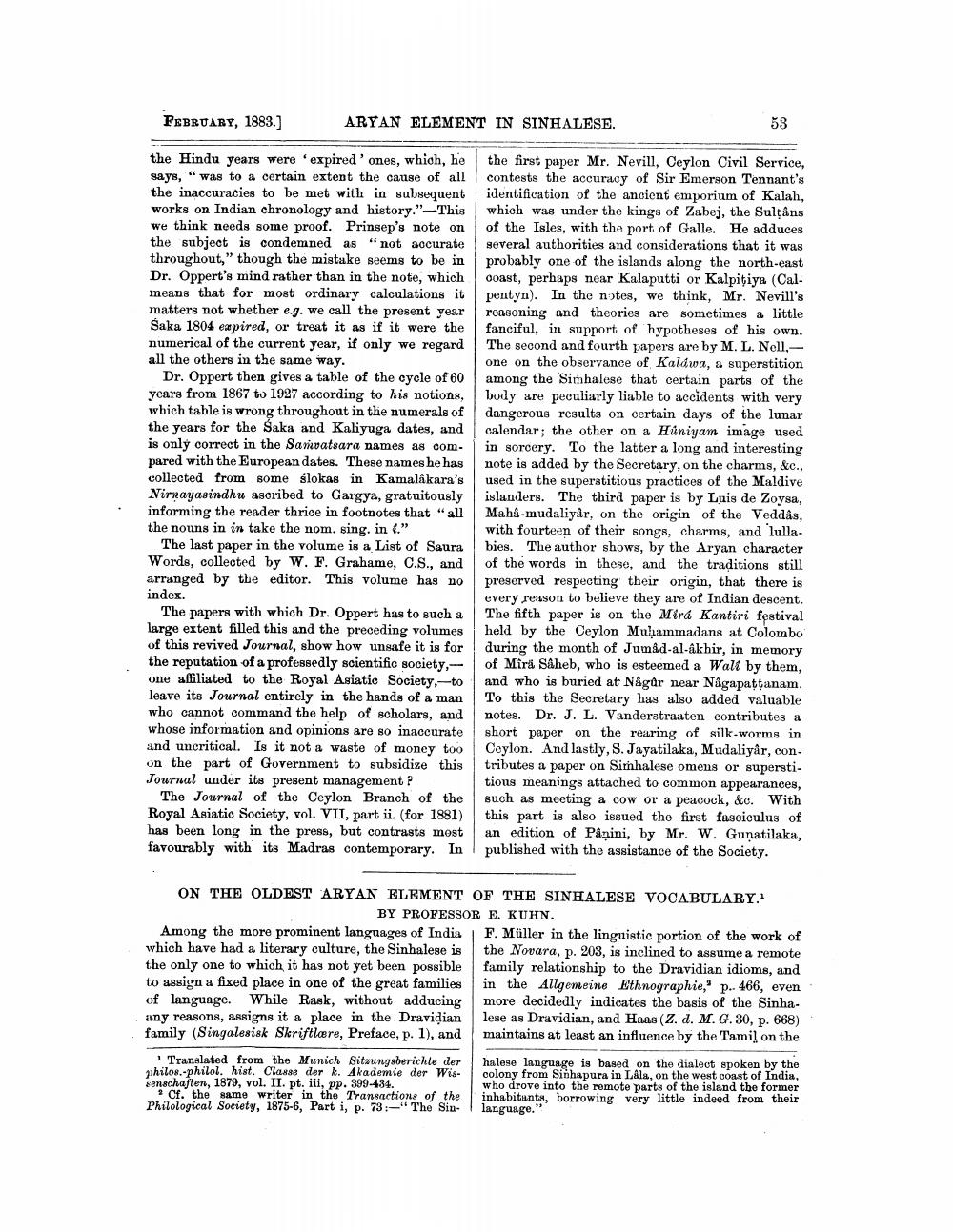________________
FEBRUARY, 1883.]
ARYAN ELEMENT IN SINHALESE.
53
the Hindu years were expired ones, which, he says, “was to a certain extent the cause of all the inaccuracies to be met with in subsequent works on Indian chronology and history." -This we think needs some proof. Prinsep's note on the subject is condemned as "not accurate throughout," though the mistake seems to be in Dr. Oppert's mind rather than in the note, which means that for most ordinary calculations it matters not whether e.g. we call the present year Saka 1804 expired, or treat it as if it were the numerical of the current year, if only we regard all the others in the same way.
Dr. Oppert then gives a table of the cycle of 60 years from 1867 to 1927 according to his notions, which table is wrong throughout in the numerals of the years for the Saka and Kaliyuga dates, and is only correct in the Sarwatsara names as com pared with the European dates. These names he has collected from some slokas in Kamalakara's Nirnayasindhu ascribed to Gargya, gratuitously informing the reader thrice in footnotes that "all the nouns in in take the nom. sing. in (."
The last paper in the volume is a List of Saura Words, collected by W. F. Grahame, C.S., and arranged by the editor. This volume has no index.
The papers with which Dr. Oppert has to such a large extent filled this and the preceding volumes of this revived Journal, show how unsafe it is for the reputation of a professedly scientific society, one affiliated to the Royal Asiatic Society,--to leave its Journal entirely in the hands of a man who cannot command the help of scholars, and whose information and opinions are so inaccurate and uncritical. Is it not a waste of money too on the part of Government to subsidize this Journal under its present management ?
The Journal of the Ceylon Branch of the Royal Asiatic Society, vol. VII, part ii. (for 1881) has been long in the press, but contrasts most favourably with its Madras contemporary. In
the first paper Mr. Nevill, Ceylon Civil Service, contests the accuracy of Sir Emerson Tennant's identification of the ancient emporium of Kalah, which was under the kings of Zabej, the Sultans of the Isles, with the port of Galle. He adduces several authorities and considerations that it w probably one of the islands along the north-east coast, perhaps near Kalaputti or Kalpitiya (Calpentyn). In the notes, we think, Mr. Nevill's reasoning and theories are sometimes a little fanciful, in support of hypotheses of his own. The second and fourth papers are by M. L. Nell, - one on the observance of Kaldwa, a superstition among the Simhalese that certain parts of the body are peculiarly liable to accidents with very dangerous results on certain days of the lunar calendar; the other on a Huniyam image used in sorcery. To the latter a long and interesting note is added by the Secretary, on the charms, &c., used in the superstitious practices of the Maldive islanders. The third paper is by Luis de Zoysa, Mahs-mudaliyår, on the origin of the Veddås, with fourteen of their songs, charms, and lullabies. The author shows, by the Aryan character of the words in these, and the traditions still preserved respecting their origin, that there is every reason to believe they are of Indian descent. The fifth paper is on the Mfrá Kantiri festival held by the Ceylon Muhammadans at Colombo during the month of Jumad-al-akhir, in memory of Mira Saheb, who is esteemed a Walt by them, and who is buried at Någar near Nagapattanam. To this the Secretary has also added valuable notes. Dr. J. L. Vanderstraaten contributes a short paper on the rearing of silk-worms in Ceylon. And lastly, S. Jayatilaka, Mudaliyår, contributes a paper on Sinhalese omens or supersti. tions meanings attached to common appearances, such as meeting a cow or a peacock, &c. With this part is also issued the first fasciculus of an edition of Panini, by Mr. W. Gunatilaka, published with the assistance of the Society.
ON THE OLDEST ARYAN ELEMENT OF THE SINHALESE VOCABULARY.
BY PROFESSOR E. KUHN. Among the more prominent languages of India F. Müller in the linguistic portion of the work of which have had a literary culture, the Sinhalese is the Novara, p. 203, is inclined to assume a remote the only one to which it has not yet been possible family relationship to the Dravidian idioms, and to assign a fixed place in one of the great families in the Allgemeine Ethnographie,' p. 466, even of language. While Rask, without adducing more decidedly indicates the basis of the Sinhaany reasons, assigns it a place in the Dravidian lese as Dravidian, and Haas (Z. d. M.G. 30, p. 668) family (Singalesisk Skriftlære, Preface, p. 1), and maintains at least an influence by the Tamil on the
1 Translated from the Munich Sitzungsberichte der halese language is based on the dialect spoken by the whilos.-philol. hist. Classe der k. Akademie der Wis- colony from Sinhapura in Lala, on the west coast of India, senschaften, 1879, vol. II. pt. iii, pp. 399-434.
who drove into the remote parts of the island the former ? Cf. the same writer in the Transactions of the inhabitants, borrowing very little indeed from their Philological Society, 1875-6, Part i, p. 73:-"The Sin- language."




